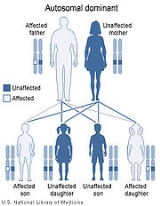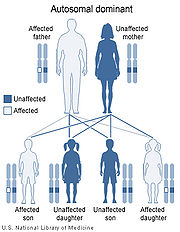
Kniest dysplasia
Encyclopedia
Kniest dysplasia is an uncommon inherited disorder of bone
growth. The condition is characterized by dwarfism
, enlarged joints, and other skeletal abnormalities, and problems with vision
and hearing
. Kniest dysplasia is a subtype of collagenopathy, types II and XI
.
. Other skeletal signs include a progressively shortened spine
due to spinal curvature (kyphoscoliosis
and lumbar lordosis), severely flattened bones of the spine (platyspondyly), dumbbell-shaped bones in the arms and legs, long and knobby fingers, and occasionally a foot deformity called clubfoot.
People with Kniest dysplasia have round, flat faces with prominent and wide-set eyes. Some infants are born with an opening in the roof of the mouth (a cleft palate). Infants may also have breathing problems due to weakness of the windpipe. Severe nearsightedness (myopia
) is common, as are other eye problems that can lead to blindness. Hearing loss resulting from recurrent ear infections is also possible.
, a molecule found mostly in cartilage
and in the clear gel that fills the eyeball (the vitreous
). Type II collagen is essential for the normal development of bones and other Connective Tissues. Mutations in the COL2A1 gene that cause Kniest dysplasia interfere with the assembly of type II collagen molecules, which prevents bones from developing properly and causes the signs and symptoms of the disorder.
 Kniest dysplasia is inherited in an autosomal dominant pattern, which means only one copy of the altered gene is necessary to cause the disorder.
Kniest dysplasia is inherited in an autosomal dominant pattern, which means only one copy of the altered gene is necessary to cause the disorder.
Bone
Bones are rigid organs that constitute part of the endoskeleton of vertebrates. They support, and protect the various organs of the body, produce red and white blood cells and store minerals. Bone tissue is a type of dense connective tissue...
growth. The condition is characterized by dwarfism
Dwarfism
Dwarfism is short stature resulting from a medical condition. It is sometimes defined as an adult height of less than 4 feet 10 inches , although this definition is problematic because short stature in itself is not a disorder....
, enlarged joints, and other skeletal abnormalities, and problems with vision
Visual perception
Visual perception is the ability to interpret information and surroundings from the effects of visible light reaching the eye. The resulting perception is also known as eyesight, sight, or vision...
and hearing
Hearing (sense)
Hearing is the ability to perceive sound by detecting vibrations through an organ such as the ear. It is one of the traditional five senses...
. Kniest dysplasia is a subtype of collagenopathy, types II and XI
Collagenopathy, types II and XI
The type II and XI collagenopathies are a group of disorders that affect connective tissue, the tissue that supports the body's joints and organs. These disorders are caused by defects in type II or type XI collagen. Collagens are complex molecules that provide structure, strength, and elasticity ...
.
Presentation
People with this condition are short-statured from birth, with a short trunk, shortened limbs, and large joints. Adult height ranges from 107 to 147 cm (42 inches to 58 inches). Progressive joint enlargement and pain restrict joint movement, which limits activity and interferes with standing and walking. These joint problems can also lead to arthritisArthritis
Arthritis is a form of joint disorder that involves inflammation of one or more joints....
. Other skeletal signs include a progressively shortened spine
Vertebral column
In human anatomy, the vertebral column is a column usually consisting of 24 articulating vertebrae, and 9 fused vertebrae in the sacrum and the coccyx. It is situated in the dorsal aspect of the torso, separated by intervertebral discs...
due to spinal curvature (kyphoscoliosis
Kyphoscoliosis
Kyphoscoliosis describes an abnormal curvature of the spine in both a coronal and sagittal plane. It is a combination of kyphosis and scoliosis. Kyphoscoliosis is a musculoskeletal disorder causing chronic underventilation of the lungs and may be one of the major causes of pulmonary hypertension...
and lumbar lordosis), severely flattened bones of the spine (platyspondyly), dumbbell-shaped bones in the arms and legs, long and knobby fingers, and occasionally a foot deformity called clubfoot.
People with Kniest dysplasia have round, flat faces with prominent and wide-set eyes. Some infants are born with an opening in the roof of the mouth (a cleft palate). Infants may also have breathing problems due to weakness of the windpipe. Severe nearsightedness (myopia
Myopia
Myopia , "shortsightedness" ) is a refractive defect of the eye in which collimated light produces image focus in front of the retina under conditions of accommodation. In simpler terms, myopia is a condition of the eye where the light that comes in does not directly focus on the retina but in...
) is common, as are other eye problems that can lead to blindness. Hearing loss resulting from recurrent ear infections is also possible.
Genetics
Kniest dysplasia is one of a spectrum of skeletal disorders caused by mutations in the COL2A1 gene. The protein made by this gene forms type II collagenCollagen
Collagen is a group of naturally occurring proteins found in animals, especially in the flesh and connective tissues of mammals. It is the main component of connective tissue, and is the most abundant protein in mammals, making up about 25% to 35% of the whole-body protein content...
, a molecule found mostly in cartilage
Cartilage
Cartilage is a flexible connective tissue found in many areas in the bodies of humans and other animals, including the joints between bones, the rib cage, the ear, the nose, the elbow, the knee, the ankle, the bronchial tubes and the intervertebral discs...
and in the clear gel that fills the eyeball (the vitreous
Vitreous humour
The vitreous humour or vitreous humor is the clear gel that fills the space between the lens and the retina of the eyeball of humans and other vertebrates...
). Type II collagen is essential for the normal development of bones and other Connective Tissues. Mutations in the COL2A1 gene that cause Kniest dysplasia interfere with the assembly of type II collagen molecules, which prevents bones from developing properly and causes the signs and symptoms of the disorder.


